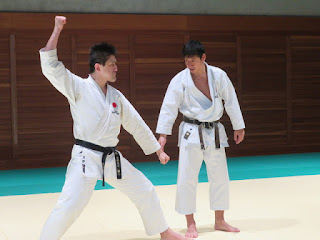by Phillip Starr
For one thing, it refers to the regular repetition of basic techniques. In my classes, students would drill the SAME basic techniques in every class for a week; we didn't drill different techniques in each class to make it more “fun.” Having fun is fine but not to the detriment of learning and developing real skill. If different techniques are drilled in each class it's next to impossible for students to really “internalize” any techniques. Their attention and effort is always changing. So we practiced the same set of techniques for a week. The techniques used for drill (which was practiced in every class) were listed and selectively chosen for various reasons. They weren't picked out just willy-nilly. And once the cycle (of techniques used for drills) was completed – which took about 6 weeks – we started all over again. And we always (and I mean ALWAYS) started off with a reverse punch and a front snap kick. I told my students that if they trained with me for the next 20 years, they'd always begin with these same two fundamental techniques.
And as students repeated the cycle over and over, I'd “tweak” the technique and body movement of the more senior students... and when I ran out of things to tweak, I'd start it all over again. AND the seniors would discover things that they'd missed the first or second or third (ad infinitum) times around. They came to understand the method behind my madness.
Consistency.
It was the same with forms. Each group (beginners, intermediates, advanced, and black belt) would practice a given form every class for a week. And I'd “tweak” those who were ready for it...
Fighting drills, which were practiced in nearly every class right after practice of basic techniques, allowed for some variation. The fighting drills were forms of one-step or freestyle one-step (see my book, “MARTIAL MANEUVERS”) that taught all of the tactics that we employ. Again, this was done cyclically. Over and over and over. And I would ensure that the way in which each tactic was employed in a given class made use of the basic techniques that we had drilled at the beginning of class.
If, for instance, we drilled a side thrust kick as one of the basics for the week, I'd try to make certain that at least 2 of the 3 tactics that we practiced would also employ a side thrust kick. The students enjoyed it and didn't notice that they were firing off dozens of side thrust kicks in class. And by the end of the week (they'd attend class three times weekly), they'd executed that kick many, many times in a variety of ways! This works much better than simply telling students to do 200 or 300 side kicks. If you do that, they get bored PDQ (that's “pretty damned quick” for you rednecks out there) and then their attention and yi (intention) wanders. In that case, they may as well not do the kick at all
Everything was set to “dovetail” very nicely. It was always CONSISTENT. For instance, if one tactic involved stepping off at a forward angle to evade the opponent's blow, what techniques could best be applied? And because we also taught grappling techniques, it was necessary that they get in lots of practice with those, too. In such a (tactical) movement, what throws or joint twists were most applicable? How could the kicks, punches, strikes, and grappling techniques be readily applied sequentially? Then the students practice those for a week. Developing this kind of training regimen wasn't easy. In fact, it took me a very long time but it worked exceedingly well.
It may not sound like it was much fun but believe me, it was! The students thoroughly enjoyed training in this way while they made good progress through progressive, consistent training. One of the biggest secrets to learning lies in how the material is taught. If the teacher presents it and practices it in a mundane manner, the students will quickly become bored. They lose their enthusiasm and their progress will suffer. On the other hand, if the instructor is enthusiastic and excited, so will the students be. This is one of the most important keys... but like everything else in training, it has to be consistent!



.jpg)




















No comments:
Post a Comment